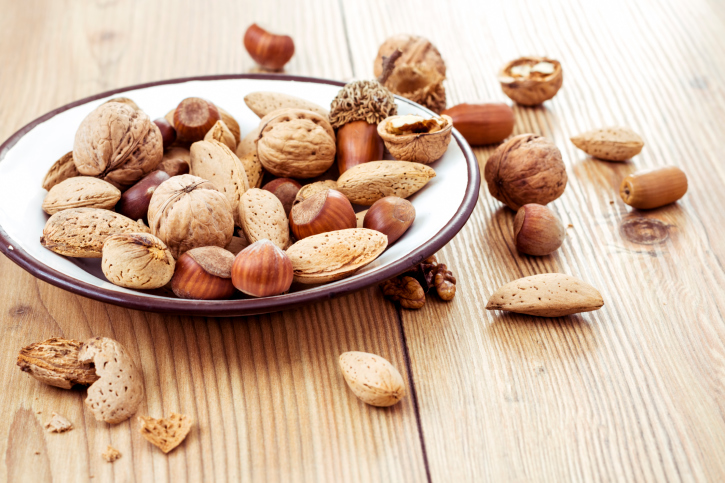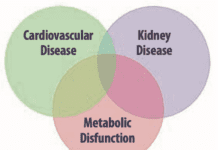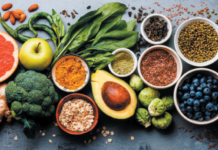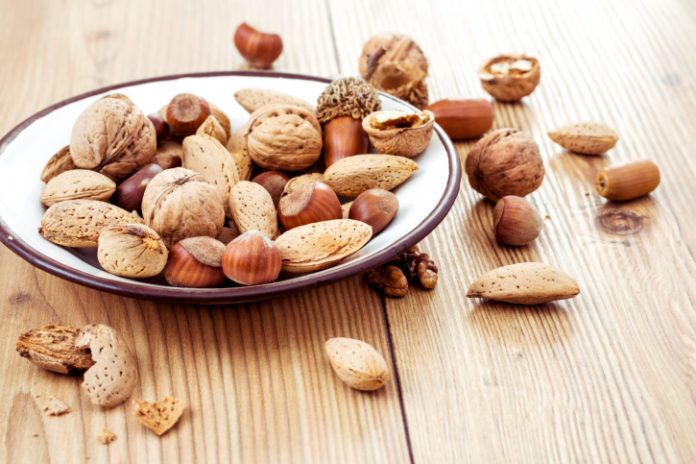Nuts are among the oldest human foods, with records of eating pistachios dating back to the Stone Age. You might describe the Stone Age as the time of discovery of the first trail mix, says Jeffrey Blumberg, PhD, director of Tufts HNRCA Antioxidants Research Laboratory. Prehistoric nomads mixed ground almonds and pistachios with chopped dates, sesame oil and breadcrumbs. Its also interesting that almonds were found in Tutankhamens tomb in Egypt.


Yet only in the past 20 years or so has science focused on nuts health benefits-most notably in preventing heart disease, but also potentially helping to combat diabetes and protect your brain and bones. Packed with nutrients and healthy fats, nuts may even be a tool in weight management, despite their high calorie count.
Marketers have been quick to promote nuts new healthy reputation, with nut-growers associations elbowing for the title of healthiest. But you can largely let taste and personal preference, rather than nutrition data, guide your shopping, says Blumberg. While there are differences between nuts, such as the relative amount of mono- versus polyunsaturated fatty acids or their different forms of vitamin E, their similarities are more important, Blumberg explains. These include being rich in good fats (and, thus calories, too), protein and fiber and vitamin E and low in carbs. Dietary variety is always better than monotony, to achieve a broader array of nutrients and phytochemicals, but the overall evidence is that nuts (and most people eat mixed nuts) are good, so you can continue to eat your favorite(s) if you wish.
Most of the foods we call nuts are tree nuts-botanically, a dry, hardened composite of the seed and fruit of trees such as the walnut or almond tree. Tree nuts also include Brazil nuts, cashews, hazelnuts (also called filberts), macadamias, pecans, pistachios and even pine nuts, which really are the seeds of pine trees. Chestnuts are also tree nuts, but are starchier and contain different micronutrients than other types. The notable exception in the nut world is the peanut: Despite commanding two-thirds of the US nut market (including peanut butter), peanuts are actually legumes, like beans or peas, and grow in the ground rather than on trees.
Nonetheless, from a nutrition standpoint, peanuts can be roughly grouped with tree nuts. Says Blumberg, There is more research on tree nuts than peanuts, but the nutrient profiles of both are quite similar and the research that is available on this topic suggests that peanuts can be considered a dietary equivalent to tree nuts.
Per capita consumption of tree nuts and peanuts actually declined for most of the 20th century, and today Americans average only half the 1.5 ounces a day that the US Food and Drug Administration (FDA) says could reduce the risk of heart disease. Only about a third of Americans eat any nuts at all on any given day, and 60% of US nut consumption is as snacks rather than in place of other proteins. Europeans eat more nuts than Americans-about 1.1 ounces daily-with consumption higher in countries around the Mediterranean. Nuts play a role in the so-called Mediterranean diet, which research has linked to a wide range of benefits against chronic disease, as well as possible protection against cognitive decline.
Nutrient Powerhouses
Nuts offer some pretty impressive health benefits on their own, too. According to an overview by Blumberg and his colleagues published in the Journal of Nutrition, Nuts are an excellent source of vitamin E and magnesium. Individuals consuming nuts also have higher intakes of folate, beta-carotene, vitamin K, lutein plus zeaxanthin, phosphorus, copper, selenium, potassium and zinc per 1,000 calories.… Nuts are an excellent source of phytochemicals (phyotsterols, phenolic acids, ?avonoids). The total phenolic constituents probably contribute to the total antioxidant capacity of nuts, which is comparable to broccoli and tomatoes.
Some of those nutty nutrients are especially important to fill gaps in the typical US diet. More than 90% of us dont get enough dietary vitamin E, which you need for immune function and protection against oxidative damage to cells. An analysis of Americans diets found that its difficult to get enough vitamin E without going overboard on fats, and that eating nuts and seeds-notably almonds and sunflower seeds-may be the most efficient solution. Per serving, nuts and seeds have the highest amount of alpha-tocopherol, one of the primary forms of vitamin E, of any food group.
Magnesium is another key nutrient most of us arent getting enough of: Americans average only about 80% of the RDA for magnesium. Chronically low intake of magnesium can increase your risk of osteoporosis, high blood pressure, heart disease and diabetes. A 2012 study reported that people with diets low in magnesium are at greater risk for stroke. Although all nuts contain magnesium, youll get the most from eating Brazil nuts, almonds and cashews.
But the health benefits of nuts mostly derive not from individual vitamins and minerals as much as from consuming a nutrient-dense food. As the preface to a report on nuts health benefits in the British Journal of Nutrition put it, Nuts are complex food matrices containing diverse nutrients and other chemical constituents that may favorably influence human physiology, a reason why these benefits may reasonably be attributed to the whole rather than the parts.
Countering Cholesterol
The best-substantiated benefit to your body from eating nuts is a reduction in the risk of coronary heart disease, primarily by lowering unhealthy cholesterol levels. In 2003, the FDA approved qualified health claims for nuts in general and walnuts in particular stating that: Scientific evidence suggests but does not prove that eating 1.5 ounces (42 grams) per day of most nuts, such as [name of nut], as part of a diet low in saturated fat and cholesterol may reduce the risk of heart disease. Nuts eligible to include this claim in package labeling, because they contain less than four grams of saturated fat per 50 grams, are almonds, hazelnuts, peanuts, pecans, some pine nuts, pistachios and walnuts.
Observational studies first drew the connection between eating nuts and lower rates of heart disease in the 1990s. In a review of the evidence published in the British Journal of Nutrition, Penn State scientists Amy E. Griel, PhD, and Penny M. Kris-Etheron, PhD, RD, pointed out, Importantly, these results have been demonstrated consistently in all population groups studied, including men and women of all ages, African-Americans, and persons with diabetes.
Subsequent clinical trials have linked nut consumption with improved cholesterol levels. This is largely due to nuts healthy ratio of good fats-mono- and polyunsaturated fatty acids, including omega-3s and omega-6s-to saturated fat, the chief culprit in raising LDL (bad) cholesterol levels in the blood. After once condemning all dietary fats as equally evil, science now understands that some fats-like those in nuts-actually reduce your risk of heart disease.
In a 2010 pooled analysis of 25 trials totaling 583 people from seven countries, Loma Linda University scientists found that, compared to control groups, those adding nuts to their diets averaged a 5.1% decrease in total cholesterol, 7.4% decrease in LDL cholesterol, and 8.4% improvement in the ratio of LDL to good HDL cholesterol. Those with high triglycerides saw a 10.2% decline. Participants, who were not on cholesterol-lowering statin medications during the study, consumed an average of 2.4 ounces of nuts daily.
Nuts were also a key component of a cholesterol-fighting Portfolio Eating Plan tested by University of Toronto researchers. In results published in 2011, nuts, plant sterols (such as found in some spreads), soy protein and foods high in viscous fiber, such as oats, barley and legumes, slashed LDL cholesterol 13%-14% without statins.
Other Heart Benefits
But the cholesterol-lowering benefits of eating nuts actually consistently outperform what would be expected from heart-healthy fats alone. This suggests, according to Griel and Kris-Etherton, that other components of nuts are also at work. These may include dietary fiber, plant proteins, antioxidants and phytosterols. The Penn State scientists concluded, Tree nuts can be an important part of a blood cholesterol-lowering diet that elicits a maximal effect attainable by diet that is comparable to low-dose statin therapy.
Other studies have tested other ways that nuts might fight heart disease. Last year, other Loma Linda University researchers showed that a form of vitamin E found especially in pecans, gamma-tocopherol, decreased unhealthy oxidation of LDL cholesterol as much as 33%. Oxidized LDL cholesterol may add to inflammation in the arteries. In another study, a diet enriched with walnuts was shown to improve the dilation of blood vessels by 64%; nuts are high in arginine, a precursor of nitric acid, which is known to expand blood vessels.
Nuts are also included in the Dietary Approaches to Stop Hypertension (DASH) eating plan, which recommends eating four to five weekly servings of nuts, seeds and beans to combat high blood pressure. In the OmniHeart study, a diet contributing about four ounces a week to plant protein using peanuts and peanut butter lowered blood pressure more than two other heart-healthy diets.
Easy on Your Blood Sugar
Besides having a healthy fat ratio, nuts are a low-glycemic-index food, meaning they raise your blood sugar more gradually than other foods. Its not surprising, then, that nuts are a good choice for stabilizing blood-sugar levels; studies have even shown that eating nuts with higher-glycemic foods can moderate those foods blood-sugar effects.
People with prediabetes may benefit from adding nuts to their diets: One study found that prediabetics who consumed an American Diabetes Association-recommended diet in which 20% of total calories came from almonds improved their insulin sensitivity, a measure of how well the body processes glucose.
If youre already suffering from diabetes, nuts might help improve metabolic factors and blood-vessel function, reducing the extra cardiovascular risk associated with the disease. Tufts scientist Oliver Chen, PhD, recently published a randomized trial of almonds in diabetics that showed the nuts improved glycemic control and lipid profiles.
Intriguing Possibilities
Evidence for nuts benefits against other chronic diseases remains tentative but intriguing. Some examples:
Among the more than 80,000 women in the Nurses Health Study, those who ate peanuts and peanut butter at least five times a week were 25% less at risk for gallbladder disease. Nuts cholesterol-lowering effects may be a factor, as cholesterol can contribute to gallstones. But the association persisted even after adjusting the findings for cholesterol and fats, suggesting that other compounds in nuts could also benefit the gallbladder.
Small animal studies have shown the consumption of walnuts may reduce the risk of breast cancer and almonds may reduce the risk of colon cancer.
Dietary intake of alpha-linolenic acid (ALA), an omega-3 fatty acid found in walnuts, was associated with improved bone health in a small 2006 clinical trial.
A new randomized trial of 447 people at high cardiovascular risk found cognitive benefits associated with eating walnuts.
Pecans have been associated with neurological improvements in animal studies, possibly because of the nuts vitamin E content. Mice fed a diet supplemented with pecans slowed their decline in motor neuron functions, such as that associated with Lou Gehrigs Disease (ALS).
Weighty Considerations
All these potential health benefits might be beside the point, however, if accompanied by excess pounds put on by munching calorie-dense nuts. The proven health consequences of obesity could cancel out many of the good things nuts bring to the table (or the snack tray). Ranging from 157 calories in just one ounce of cashews to 204 for macadamia nuts, even a handful of otherwise healthy nuts can boost your daily calories by 10% or more.
Surprisingly, though, people who eat more nuts dont typically weigh more. In fact, a 2011 Harvard study that singled out another popular snack, potato chips, as the number-one contributor to weight gain among 120,000 adults over 20 years, found an inverse relationship between nuts and weight gain. Nuts ranked second only to yogurt as a food linked to weight loss.
A 2007 review of the evidence on nuts and weight found much the same thing: Epidemiological studies document an inverse association between the frequency of nut consumption and BMI (Body Mass Index). Clinical trials reveal little or no weight change with inclusion of various types of nuts in the diet over one to six months. Moreover, weight-loss plans that allow nuts have greater compliance and better results.
Whats going on? Other studies have shown that nuts tend to fill you up, leading to lower consumption of other foods totaling 65%-75% of the calories consumed in nuts. Moreover, not all the calories in nuts may be absorbed by the body, passing right through without being digested.
Tufts Blumberg explains, A significant amount of the fat in almonds is not bioaccessible-released from the food matrix, a prerequisite step before absorption-and so does not contribute to actual calorie intake as much as would be calculated. This is probably true of other nuts. Thus, the lack of association with nut consumption and overweight/obesity; indeed, there is a slight inverse correlation between the two.
It could even be, as other research suggests, that regular nut consumption increases the rate at which your body burns calories when at rest.
The only reason not to eat nuts may be that theyre among the foods most connected to food allergies. People who are allergic to one type of tree nut may be more likely to also be allergic to others, although not peanuts since those are actually legumes. Similarly, those with a peanut allergy might be able to eat tree nuts. In either case, caution is called for given the risk that nuts youre allergic to might have been processed in the same facility. Given the potentially serious health consequences of such allergies, check with your healthcare specialist if you suspect you have a nut allergy.
Smart Substitutions
Despite the research showing that nuts are not a major contributor to weight gain, simply adding nuts to your diet is not as smart a strategy as eating them in place of less-healthy foods. Says Blumberg, Since nuts are typically consumed as a snack (where we consume lots of junk), eating nuts instead of chips and cookies is a good approach.
But dont stop with snacks. If you typically top your salads with croutons out of a box, try nuts for that extra crunch instead. Including nuts in a stir-fry dish gives you a different protein to chew on, meaning you can use a little less meat. Pesto, combining nuts with greens ranging from basil to spinach, makes a flavorful topping for whole-grain pasta that contains far less saturated fat and calories than alfredo-style sauces. (See this issues recipe for whole-wheat pasta with spinach-walnut pesto and zucchini ribbons.)
Theres a reason, after all, that humans have been nibbling on nuts for nearly 10,000 years: They taste good. Now that we know nuts are also good for us, its all the more reason to enjoy them as part of a healthy diet.
























